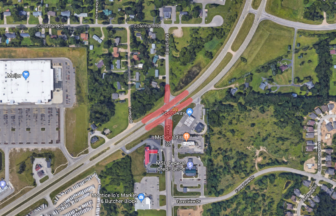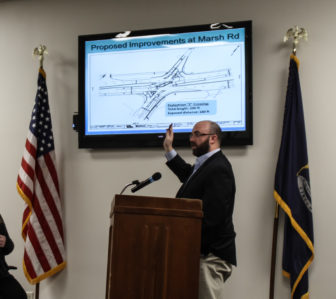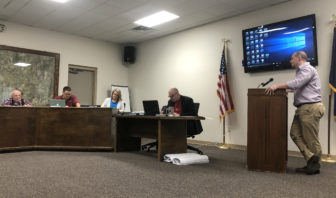The Michigan Department of Transportation (MDOT) presented a plan during the Bath Township Board of Trustees meeting on Feb. 20 to reconstruct the intersection on Business Loop I-69 and Marsh Road, aiming to make it safer and more efficient.
The state-funded plan is to transform the current intersection into a J-turn format, with a pedestrian crossing to allow for non-motorized access through the intersection, which would restrict northbound vehicle traffic up Marsh Road short of the neighborhood past the intersection.
It also has federal funding from the Congestion Mitigation and Air Quality Improvement Program to help reduce traffic build-up and improve air quality with less idling at the stop lights.

The MDOT proposal’s location as indicated by the red highlighted area, on the BL I-69 and Marsh Road intersection. Map via Google Maps.
However, the plan has been met with mixed reviews from township residents and board members.
One of the biggest concerns has been restricting the direct northbound access on Marsh Road.
“The ability to not go straight is going to be a real hinderance, at least with the proposed plan,” said Samantha Goris, a Bath resident who lives near the intersection and uses it regularly. “It would definitely cause significant changes for things, because without the ability to go straight, I don’t know where they would put the Michigan Left.”
A “Michigan Left” is the combination of using median U-turn following a right turn on an intersection that doesn’t allow a direct left turn. The U-turn puts the driver in the same direction as the direct left would if it were present.
“The north-south traffic is inconvenient, they’re completely cut off from the rest of the developed area [in the proposal],” said Kyle Bennett, a Bath resident and daily user of the intersection. Bennett said he believes the proposal doesn’t address all of the issues.
Tom Fisher, operations engineer for the Lansing Transportation Service Center, MDOT’s Lansing office for highways in the area, said losing the direct access on Marsh Road through the intersection would not be as bad it seems.

Operations Engineer Tom Fisher lays out MDOT’s proposal to the Bath Board of Trustees on Feb. 20. Photo by Ben Clemens.
“One of the things we’re doing by simplifying the overall traffic signal operations [is] we’re making it a lot snappier,” said Fisher. “So, you’re actually going to experience a lot less delay while you’re sitting at the intersection. So, actually having to turn right, go to the indirect crossover to the east, and then turn left and come back to Marsh, you’re not going to see a lot of big time difference between that movement than just waiting there to get your green to go straight through the intersection.”
The other main aspect of the proposal is aiming for safer non-motorized access for pedestrians and bikers through the intersection via the revised crossing.
“I’m excited for the possibility of a pedestrian crossing,” said Goris. “I’d love to be able to walk my daughter to daycare or walk to Monticello’s [Market] or ride my bike down to Lake Lansing. As it stands, I would not walk through or bike through [I-69] at all, it’s not safe.”
“It’s a tremendous benefit for Bath Township,” said trustee Dan Stockwell, who is also a member of the Tri-County Bicycle Association. “From the non-motorized point of view, the ability for people on bicycles, walking or in wheelchairs to have the ability to cross that intersection safely with minimal points of conflict.
“It’s not one would not ride my bike through today.”
The new pedestrian crossing is part of what prevents the direct access on Marsh Road through the intersection.
At the meeting, Fisher said the crossing will create a lower rate of exposure to traffic with the help of refuge islands for those crossing, compared to the current scheme where those crossing are exposed for the whole duration.
“If we have more conflict points at an intersection, there’s a higher potential of crashes there,” said Fisher during the board meeting presentation.
“I understand that there’s people that want to walk, I won’t be walking this, that’s for sure,” Bennett said during the public comment at the Feb. 27 Bath Township Planning Commission’s meeting.
“It’s not perfect for sure, but I think it will do what it needs to do,” said Stockwell.
As the plan stands, MDOT anticipates having the construction done by January 2019.
One issue for trustee Cindy Cronk, who is also on the township’s planning commission, is how MDOT went about presenting the plan, noting a lack of communication with the commission.
“[The plan] should’ve been brought to the planning commission when it first came up,” said Cronk. “I want them to listen to the planning commission, I want them to listen to the residents of this town.”
“MDOT has been very receptive, they’ve listened to all the concerns, they’ve made several presentations for the Bath Board of Trustees,” said Stockwell.
“[MDOT] has not engaged,” said Cronk.
During the commission’s meeting, several questions were raised from members to Planning Director Brian Shorkey due to the apparent knowledge-gap on the proposal.
Shorkey said his role in the project has been representing the township in meeting with MDOT and informing the commission on the plans by MDOT. However, the planning commission only acts as an advisory group to MDOT, with no formal power in the decision making process.

Kyle Bennett, far right, addresses his concerns over the MDOT plan to the Bath Planning Commission on Feb. 27. Photo by Ben Clemens.
“It would be nice if MDOT would include [the planning commission] in the project, since it does involve their residents,” said Bennett.
Cronk also raised concerns over the accident data used by MDOT to justify the proposal, given there’s no timeframe listed to when data applies on the presentation, since the intersection recently went over adjustments that might not be factored into the data.
“Can we at least bring to the table that we know that all of [MDOT]’s data is outdated,” Cronk said at the commission meeting. Cronk said the data is not based on how the intersection is currently structured, which she said MDOT told them.
“We do five-year analyses on all of that,” said Fisher. “I don’t know if that’s five years going back starting in 2017 going back five years, or if that was when we started the project in our initial data.”
The plan began “in either 2013 or 2014,” said Fisher.
“If that data has not been analyzed with changes to the current environment, from a statistical standpoint then it’d be considered invalid,” Bennett said to the commission.
As for what value this proposal would have for the town, Bennett is worried the plan would have be detrimental to the businesses around the community.
“By taking away the northbound movement through the intersection, it makes the marketability of the northeast property of that intersection a little bit more difficult,” said Shorkey.
Stockwell remains positive on the plan’s impact.
“We always invite people to come visit Bath Township, and we hope we’ll encourage more visitors to arrive by bicycle,” said Stockwell.